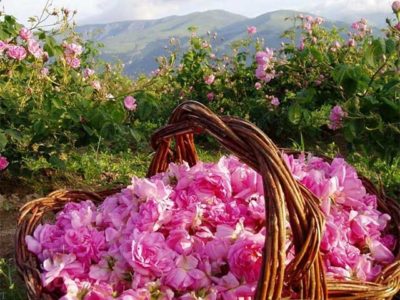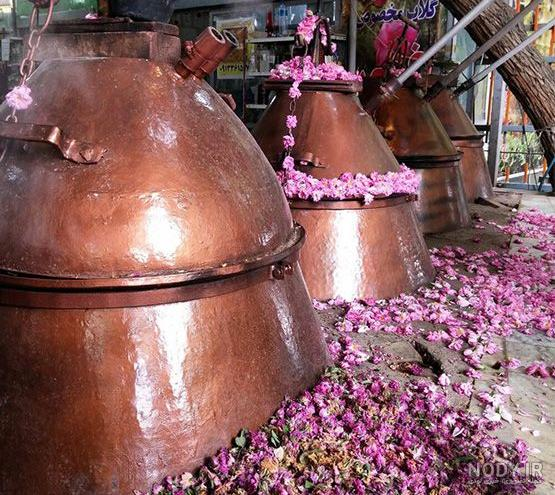Kashan Rosewater Festival
Iran is a wide country with diverse culture, climate and folks. Different towns have their special traditions, tales, rituals. Each season has its unique rituals. Spring is a season in Iran with the most beautiful scenery. The second month of spring is called Ordibehesht ,which reminds you of heaven, as “Behesht” is the Persian equivalent of heaven. In Kashan from the middle of Ordibehesh till the middle of Khordad there is a ritual called “Golabgiri” which refers to the set of actions taken to produce rosewater using Damak rose. The process includes collecting flowers, cleaning them, boiling them and changing them into rosewater. An excursion to watch this process is both enjoyable and non-forgettable. It is usually done in mountain areas of kashan such as Niyasar where Damask roses have a better quality. Apart from watching this ritual you can see beautiful waterfall of Niyasar. Apart from the excursion you experience, there are some benefits available for rosewater. Therefore, you can buy souvenir that is perfect for your heath.
Benefits of rosewater
Rosewater has been used for centuries for its therapeutic benefits. Here are some of the therapeutic benefits of rosewater:
- Soothes skin irritation: Rosewater has anti-inflammatory properties that can help soothe irritated skin. It can be used to treat sunburn, rashes, and other skin irritations.
- Helps balance skin pH: Rosewater has a pH level similar to that of our skin, which makes it an excellent toner for balancing the skin’s pH level.
- Hydrates and moisturizes skin: Rosewater is a natural hydrator and can help moisturize the skin. It can be used as a facial mist or added to a moisturizer.
- Reduces redness: The anti-inflammatory properties of rosewater can help reduce redness and inflammation in the skin.
- Relieves headaches: The aroma of rosewater can help relieve headaches and migraines. It can be used in a diffuser or added to a bath.
- Aids in digestion: Rosewater can be used to aid in digestion. It can be added to tea or used in cooking.
- Calming effects: Rosewater has a calming effect on the mind and body. It can be used in aromatherapy or added to a bath to help promote relaxation.
Overall, rosewater is a versatile ingredient that can be used in a variety of ways to promote health and wellness.
The process of rosewater production
As we mentioned before, rosewater has a wide range of uses, including in cooking, beauty products, and aromatherapy. Also I was said that Kashan is a city in Iran which is famous for its rose gardens and the traditional production of rosewater. Here are the traditional steps for making rosewater in Kashan:
- Harvest the roses: The rose petals are harvested early in the morning when they are still covered in dew. The petals are carefully picked by hand to avoid bruising.
- Load the petals into the distillation vessel: The petals are loaded into a large copper vessel called a deg or a degh, which has a long spout on top.
- Add water: Distilled water is added to the vessel, and the petals are left to soak for a few hours.
- Heat the vessel: The deg is then placed over a wood fire, and the water is brought to a gentle boil.
- Collect the rosewater: As the water boils, steam rises through the spout and condenses on a flat, inverted lid that covers the top of the deg. The condensation then drips into a container, collecting the rosewater.
- Separate the rosewater from the essential oil: After the rosewater is collected, it is left to settle for a few hours. The essential oil of the roses rises to the surface and is carefully removed with a spoon. The remaining rosewater is then bottled.
- Store the rosewater: The rosewater is stored in cool, dark places, away from sunlight and heat.
The traditional method of making rosewater in Kashan is a labor-intensive process that requires a lot of skill and patience. The use of copper vessels is believed to impart a unique flavor and aroma to the rosewater. The production of rosewater in Kashan dates back centuries and is an important part of the city’s cultural heritage. So when you travel to IRAN within late April and Early May, take your time to see Kashan unique rosewater production as a cultural fun activity.
List of historical sites of Kashan
Kashan is a city located in the Isfahan province of Iran, and it has a rich history dating back over 7,000 years. Here are some historical sites to visit in Kashan:
- Fin Garden: This is a beautiful Persian garden dating back to the Safavid era (1501-1736).
- Agha Bozorg Mosque: This mosque was built during the late 18th century, and it features intricate Islamic architectural designs.
- Tabatabaei House: This is a traditional Iranian house that was built during the Qajar era (1785-1925), and it is known for its beautiful interior decorations.
- Sultan Amir Ahmad Bathhouse: This is a 16th-century bathhouse that was built during the Safavid era, and it is known for its stunning architecture.
- Borujerdi House: This is another traditional Iranian house that was built during the Qajar era, and it is known for its intricate decorations and design.
- Sialk Ziggurat: This is an ancient archaeological site that dates back to the 3rd millennium BCE, and it is one of the oldest ziggurats in the world.
- Ameri House: This is a beautiful traditional Iranian house that was built during the Qajar era, and it features stunning stained glass windows and intricate decorations.
- Tepe Kashan: This is another ancient archaeological site that dates back to the 6th millennium BCE, and it features ruins of ancient settlements and artifacts from different eras.
- Abbasian House: This is a traditional Iranian house that was built during the Qajar era, and it features beautiful decorations and a stunning interior.
- Bagh-e-Fin Bathhouse: This is a 16th-century bathhouse that was built during the Safavid era, and it features beautiful tile work and intricate designs.
As mentioned above, Kashan has so many places to offer to be visited. If you are interested in seeing these sites, there is an itinerary that Kashan is also included.

